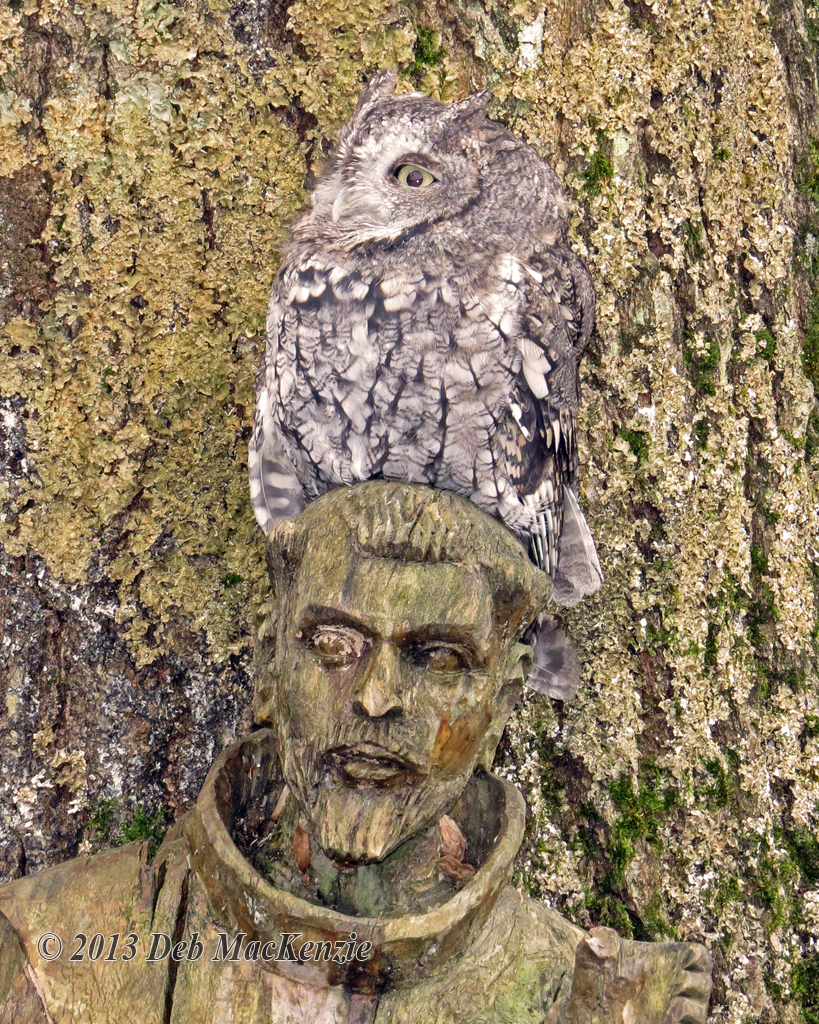"The screech-owl, with ill-boding cry, Portends strange things, old women say;
Stops every fool that passes by, And frights the school-boy from his play."









Red Phased Eastern Screech Owl by Anne Fraser
Left, Raisin by Brenda Dadds Woodward, Right, Gorda, a male from Florida, and Raisin, a female from Missouri
Photo by Steve Hall
|
Eastern Screech Owl Megascops asio There is an amusing scene in the comedy “My Cousin Vinny”, where the Joe Pesci character, an inexperienced lawyer from Brooklyn, where local wildlife tends towards pigeons, rats, crows, and stray cats, is staying in a remote back woods Alabama cabin, preparing for the big murder trial, and is startled by a blood curdling shriek in the dead of night. He explodes out the front door, wildly firing a pistol, as the camera suddenly focuses down on a small screech owl in a tree. Eastern Screech
Owls resemble
adorable little plush toys, but are stone killers, often heard, but
seldom
seen. They occur from grey to brown to rufous color phases, as well as
in
intermediate phases, all of which can intermate. About a third of all
Eastern screech
owls are reddish with the percentage declining as you survey further
north and
west. Western screech owls are gray. Screech owls weigh four to nine
ounces,
are seven to ten inches tall, and have a stubby wingspan of 18 to 24
inches. As
with other owls, females are larger than males, with females doing most
of the
incubation and nest defending, and males bringing prey back to the
nest. The screech owl’s stocky but short
appearance appears
neckless, and features small “ear tufts”, display feathers, which have
nothing
to do with hearing, but break up the top of the owl’s head, helping
camouflage
the owl. Large talons attach to feathered tarsi, making the screech owl
a
powerful little hunter. When flying through woods, they are more like a
stubby jeep
than a sports car. If a screech owl worries about being spotted by a
predator,
such as another owl, or a passing person, it may close its yellow eyes,
tightening
its feathers, while stretching and twisting its torso to present a
narrower
silhouette, which may resemble a broken snag or branch, and they may
blend in
with the tree bark. The only owl smaller in the Adirondacks is the saw
whet
owl. It is tough out there in nature. Starvation
tends to be the
number one killer of wildlife, with bears being the sad exception,
dying more
often from the rifles of hunters, homeowners, and rangers. Owls are not
sentimental, with great horned owls preying on all smaller owls, such
as barred
owls, as well as crows, hawks and even eagle chicks. Barred owls in
turn prey
on long eared owls, barn owls, screech owls and even tiny saw whet
owls, who
may themselves fall victim to screech owls. Screech owls perch on branches as low as ten
feet high,
observing what moves beneath, and diving at mice, voles, rats,
chipmunks, but
will also go after small birds like starlings, finches, wax wings, and
even bats
in flight. Grouse sized birds are occasionally taken. Screech owls will
use
bird baths for bathing and drinking and will monitor nearby bird
feeders for
vulnerable songbirds. Blue jays, chickadees and other small birds make
a noisy commotion
when discovering a roosting screech owl, mobbing, and harassing them,
trying to
force the screech owl to leave an area, while alerting other songbirds
to the
potential danger. Hunting primarily from dusk for several hours, as
well as around
dawn, no small critter is safe, and screech owls will grab large flying
insects,
as well as snakes, frogs, salamanders, and crayfish. As with other owls, screech owl hearing is
aided by asymmetrical
ears, one higher and larger than the other, located behind the eyes,
which
enables the owl to triangulate the location of prey. Sounds hit one
ear, up or
down, left or right, a microsecond before hitting the other. The eyes
are fixed
in the socket and cannot rotate, so when the owl hears a sound, they
coordinate
the arrival of the sounds by swiveling their heads up to 270 degrees,
on their fourteen
neck vertebrae, twice the number we have. When
the sounds land simultaneously, by
definition, the screech owl is staring at the location the prey pretty
much must
be. Screech owls are nocturnal hunters. The eyes
are long and
tubular and have many more rods, which detect motion and change, than
cones,
which resolve color. As with other owls, little movement escapes their
attention.
The flight feathers are fringed, softening the sound of flight,
allowing the
owls to take their prey by surprise. Owls lack crops, which other birds use to
store food for
later consumption. At the same time, they have no teeth, so they cannot
chew
their food, and they cannot digest bone, feathers, or fur. Prey are
usually
swallowed whole or brought back to the nest to be dismembered by beak
and
talon, and then shared. The owl’s digestive system is composed of
two parts: the
smaller proventriculus produce enzymes, mucus, and acid, which begin
the
digestive process, while the next stop, the larger ventriculus or
gizzard,
separates the indigestible parts, forming a pellet, which is stored in
the
proventriculus before being regurgitated by the owl hours later.
Screech owls
produce about two pellets per day, and the owl cannot swallow prey
again, until
the pellet is ejected. The pellets are in great demand by kids visiting
the
Wildlife Refuge, who will then dissect them in the classroom to see
what the
owl has been eating. Eastern Screech owls range from the Rockies
east, preferring
overlapping undefended territories of 100 to 200 acres, mainly in older
deciduous
and mixed forests with many natural cavities like woodpecker holes.
hollow
branches, tree stumps or even man-made boxes, built to that purpose, or
inadvertently having the right dimensions to serve as such. Older
coniferous
forests work as well, and favored territories border open fields and
wetlands,
which provide most of their prey. Screech owls are solitary creatures,
except
during mating and nesting seasons, and do not migrate. Because of their diminutive size and the
difficulty in
spotting them, screech owls easily live among people in suburban
settings, and
even urban settings in parks. Think about it. Most folks hear barred
owls,
which defend larger territories, calling frequently, and occasionally
see them
from time to time, but few people have noticed screech owls, even
though there
are more of them than barred owls in areas where both occur. Screech
owls are
only found in the new world, with most found in the lower 48 states.
Estimates
put their total population of all 23 recognized species at about
900,000. Uncovered fossils indicate that
screech owls,
as they appear today, go back about 2.5 million years, with species
diversifying up to 5 million years ago. Threats to screech owl survival
include
warmer seasonal weather, forest fires, habitat destruction and
predation by
larger owls, weasels, snakes, and corvids. Like most owls, screech owls are monogamous,
but before
occupying the nest, which is often the same one chosen by the female
the year
before, there will be a sort of stiff courtship, with males and females
calling
each other as they move closer. As Cousin Vinny discovered, male screech
owls may announce
their presence within their territory with sharp, piercing calls, as
well as a
mournful thirty-five note trill, which can resemble a high-pitched
horse
whinny. When courting, males will call repeatedly from progressively
closer
branches until male and female are together. The male bobs and swivels
his
head, dips his entire body, and even slowly winks one eye at the
female. If she
ignores him, bobbing and swiveling motions intensify. To accept him,
she moves
closer, and they touch bills and preen each other. Pairs mate for life
but will
accept a new mate if the previous mate disappears. Males will maintain multiple nesting sites,
averaging ten to
twenty feet above ground, within a much smaller ten-to-twenty-acre
section of
their territory, which they will defend, and during mating season will
store food
in each of them as an enticement to females to choose a particular
nest.
Occasionally, this system may result in an exhausted male supporting
more than
one female’s nest. Young are raised between March and May. The
female will
incubate a clutch of two to six eggs for about 27 to 34 days, while the
smaller
nimbler male will bring her prey. The egg laying is sequential, with
the first
born often taking advantage of younger, smaller siblings, occasionally
pushing
one out of the nest, committing siblicide, to garner a greater share of
the
food the male is bringing to the female. The fast-growing chicks beg
for food
with a peeping sound for their first few weeks, which becomes a more
insistent
“keeer-keeer” sound as they near fledgling size. At about a month, the fledges are branching,
climbing out of
the nest, perching on branches, exercising their wings in preparation
for that
first flight. As with other owls, the first attempt at flight may be a
bust,
with the fledge ending up on the ground, being fed by mom until the
fledge is
strong enough to fly on its own, or a predator, such as a skunk, comes
across
it. First year birds grow larger flight feathers than their parents
have, to
compensate for their relative lack of strong flight muscles. Screech
owls live
an average of ten years in the wild, twice that in captivity. Steve Hall
|
Red Phased Eastern Screech Owl by Dr. Greg Gulbranson
Raisin, photo by Bill Woodall
Raisin, photo by Bill Woodall


Screech Owl Range, Raisin on Saint Francis by Deb MacKenzie

Raisin with Wendy
| Home |
Release of
Rehabbed Animals |
Learn
About Adirondack & Ambassador Wildlife |
Critter
Cams & Favorite Videos |
History
of Cree & the Adirondack Wildlife Refuge |
Volunteer & Sub-permittee Jonas with Raisin
Great site for owl information and resource